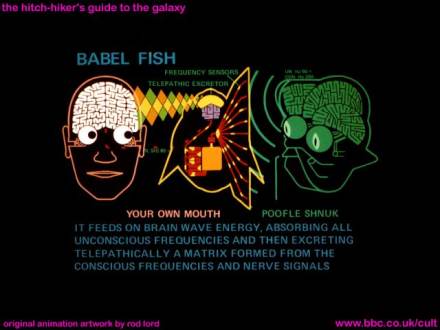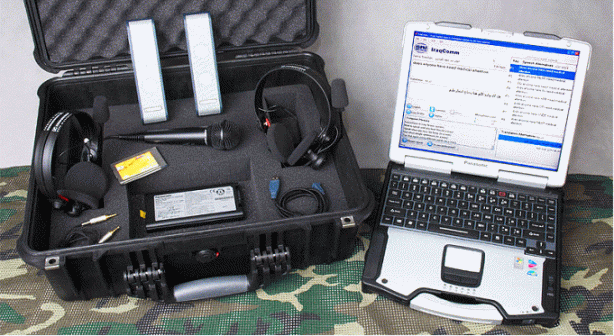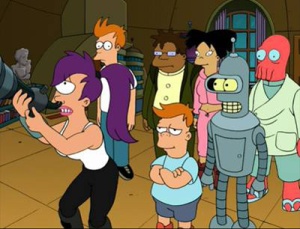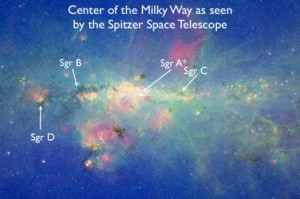Ever wondered where Babelfish online translator got his name from? Yup, that’s correct. In the Hitchhiker Guide to the Galaxy, this small yellow and whimsical symbiotic creature could be placed in your ear and, automatically, you’d understand every language in the galaxy. Literally “It feeds on brain wave energy, absorbing all unconscious frequencies and then excreting telepathically a matrix formed from the conscious frequencies and nerve signals picked up from the speech centres of the brain”. Useful, right? Of course, you’d speak your same old language, but since everyone would be carrying his/her own fish … voila! universal understanding! (of the language, mind you).
This concept has been used again and again in scifi, both from a biological point of view -John Crichton in Farscape gets injected with with bacteria called translator microbes that works almost exactly like the babel fish- or technologically -the Universal Translator gadget is quite well known in the classic Star Trek series- . In other scifi works, sentient beings have apparently managed to agree on something at last and basically speak the same language (e.g. english-chinese in Firefly).
In fact, anyone who’s ever used a browser in the last few years have seen a translator in action. When the page you are browsing is in a language your browser is not configured in, there’s this little message offering to translate it for you. If you have ever said yes, you’ll know why we are not getting one of these Star Trek gadgets for Xmas anytime soon: unless you are translating from or to english, you’ll probably get a laugh at whatever the translator throws to you. Natural language processing is far from easy and, although there are many researchers working on the field at the moment, it is not solved except for the simplest constructions and only for well spread languages (english, mostly). Actually, a portable translation device implies several difficulties:
– An automatic speech recognition (ASR) system, adapted to the specifics of every different language and also to every potential speaker. Actually, you can dictate stuff to your smartphone and it -more or less- transcripts it into text, but reliable systems mostly require training to get adapt to its user’ voice and a grammar to fix speech recognition errors automatically.
-Assuming that you’ve got a correct transcription of whatever you’ve said, you need a natural language recognition system and a well trained machine translation (MT) system to swap languages. This is the really hard part, as commented above. On the fly translation would be probably impossible, because reliable translation of almost every language requires at the very least to finish a sentence to see what the speaker really meant to say.
-Finally, if we really had a translated transcription of whatever the speaker was trying to say, we would need a good text-to-speech synthesis (TTS) system, capable of reproducing the inflections and twists of the translated language. In a language like english, you just sound dumb, but in others like chinese, the meaning of a sentence can change completely. This, however, is the easiest part of the problem.
All in all, one can cope with the above challenges one language at a time. Universal translation may still be an utopia, but there are -more or less- portable translators working nowadays, mostly for the military.
Iraqcommpack, developed under the DARPA program Spoken Language Communication and Translation System for Tactical Use (TRANSTAC), can reportedly run on a tablet or handheld PC and performs bidirectional, speech-to-speech machine translation between English and colloquial Iraqi Arabic. Basically, one speaks into the microphone, whatever one has said appears on screen or is repeated vocally -for checking- and, once validated, it is translated and “spoken” in the target language. However, they report that “to simplify and speed up communication”, the system provides a shortcut menu of frequently used phrases, so one would expect that Iraqcommpack is not as intuitive and fast as to provide fluid conversation.
However, people is currently working in this direction, since there is a market for this technology. For example, Speech Technology and Research (STAR) Laboratory promises services running on a smartphone.
And, in the meantime, you can download here several scifi language translators.




